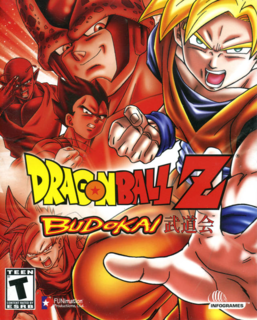Although not the best fighting game by any means, it does however provide a faithful representation of the series while
The story of Dragon Ball Z Budokai follows the anime rather closely. Specifically, the Sayian, Namek, and Android Sagas are targeted, beginning with the fateful encounter with Raditz and ending with a final battle between Gohan and Cell in his perfect form. This should be nothing new for fans of the series and those interested in the story would be better off watching the anime or reading the manga as being in a form of entertainment that allows more focus on stories, include many explanations that gamers not familiar with the series may have. The main story mode itself is a series of fights or similar situations often with special conditions in place. Between the fights or action sequences are rather long cut scenes that explain the story at the current time. These scenes feature full voice overs that seem to have been produced by the original cast. The result is a faithful representation of the source material along with rather interesting cut scenes, at least the first time through. The music that is heard during the cut scenes and during the battles fits rather nicely as well. it’s a shame though there was not too much variety incorporated into the music, as it will become all to quickly rather redundant and generally not as impacting as it may have intended to be.
The battles themselves are rather fast paced and consist of many varying techniques between the fighters. The movement is a bit restricted though and can be annoying at times, causing many just to engage in face to face battle in order to win the match. This gives the game a feeling of being a button masher and it becomes apparent that it does not contain the same level of depth as some of the other fighting games available. This does not mean that no strategy is involved during battle, as there are quite a few options to employ in order to defeat one’s opponent. Characters can use many different kicking and punching combinations, as well as energy attacks. There is also an option to guard, although each attack guarded against drains one’s Ki energy. Energy attacks also depletes one’s Ki and one can restore Ki by attacking the opponent or by charging using a special move that leaves one open to attacks while one is charging.
Now, one may be wondering what special attacks each character has and how to use them. The truth is, the game allows one to customize each character with special capsules that enable a varying amount of moves to be performed. Each character has only seven slots for such moves though, and some take up more then one slot. This adds a great deal of length to the game which is sorely lacking otherwise. The story mode is short, especially without the cut scenes. The other modes aren’t really that interesting themselves and gamers will only find an incentive to come back by the rather large amount of capsules to collect and the different move sets one can create for each character, which are rather unique in themselves.
Although the characters themselves look alright and often rather creative, the game won’t wow gamers with visuals. This can become most apparent with the stages which are rather too few to begin with. They basically encompass of the common fighting grounds such as fields and valleys and contain a bit of interaction as well, although nothing to boast about. In the end, Dragon Ball Z Budokai does have its problems and won’t be contesting with the likes of Smash Bros. or Soul Caliber any time soon, it is a step in the right direction for a franchise that had seemingly been doomed to horrible cash ins within the video game industry.

